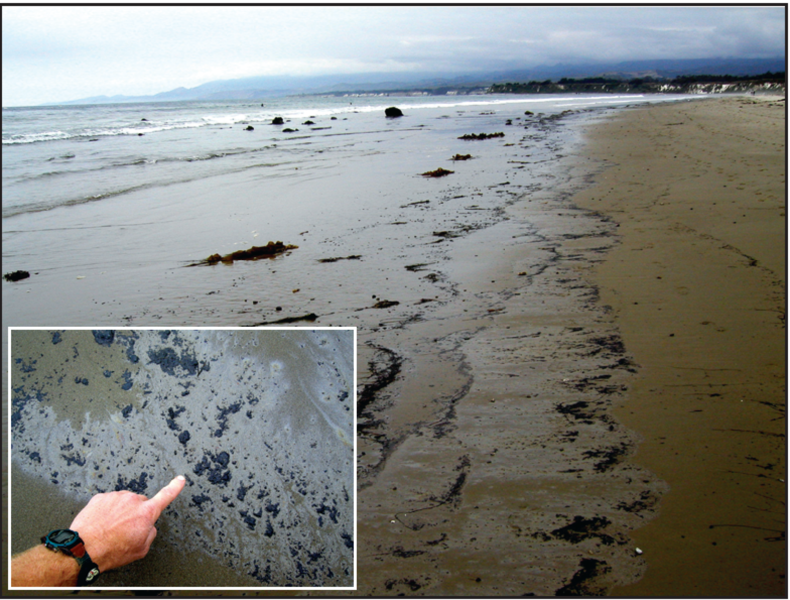The oil wells of Platform Holly, located two miles offshore Goleta, have been successfully plugged and abandoned. Coincidentally, I have observed a dramatic reduction in the amount of tar in the water and on the beach in places like Devereux Point, the surf spot Sands, and Haskells Beach, near the Bacara Resort ever since the wells of Platform Holly have been shut-in circa mid-2015.
Platform Holly was completed and began producing oil in 1966. I began wandering up to the Goleta area in search of surf in 1970. Starting in 1973 and until 1977, I began surfing and otherwise enjoying the beaches of Goleta regularly while I lived in Isla Vista during my matriculation at UCSB.
The beaches of Goleta at that time were notorious for the copious amounts of tar on the beach and in the water. You could not surf in the water or walk on the beach then without accumulating beach tar on your feet and the deck of your surfboard. In Isla Vista, the floors of everyone’s showers and tubs were black. It was in our hair and on our clothes. We each had our favorite method for removing it from our feet: Some preferred gasoline and lighter fluid and while others preferred olive oil, mayonnaise, and peanut butter.
We were told that the beach tar was a natural phenomenon from seeps located offshore; that the oil had been seeping from subsea fissures for a long time, and that the Chumash had used it to caulk the planks of their seacraft and as an important trade item. Hardly anybody I ever knew blamed the oil companies for the tar on the beach, as we all assumed that it was natural and lived with it as one does with natural and unavoidable inconveniences.
In 1987, I returned to Goleta and began to once again enjoy the beaches here. In the meantime, production had peaked at Holly in 1984 and a metal tent had been placed over one of the most prolific seeps to capture oil and gas as part a program financed by Exxon to offset pollution from proposed offshore oil development on the Outer Continental Shelf in the Santa Barbara Channel. The beach tar was as bad as ever.
Almost 12 years ago, I retired and began to dedicate my time to other pursuits, one of them being to increase the number of days that I go surfing. Consequently, for nearly 12 years now I have spent a lot of time at the beach and in the surf. I have taken note of the amount tar in the water and on the beach (and on my surfboard, my cheeks, and my ears). The following observations are not science. It is important that I state that up front. These are only the observations of an aging surfer with too much time on his hands to think about stuff that he sees on his daily trips to the beach.
I have been going to beach in Goleta and the Gaviota Coast to surf, walk, run, or just sit and gaze at the ocean for more than 50 years. In that time, I have developed some observational predictions about the timing and volume of tar on the beaches. For instance, I have noticed a strong correlation between wind direction and the amount of nearshore tar “slime” in the water and deposits of “globs” of tar on the beach. In my experience, offshore north winds and strong west winds blowing down the channel seem to keep the tar away from nearshore waters and the beaches of Goleta and Gaviota. On the other hand, iight southwest, south, and southeast winds tend to bring both slime and globs to shore. I have observed that other meteorological and ocean swell conditions also affect the prevalence of tar in the nearshore waters and on the beach.
Recently, I have noticed the greatest diminishment of oily slime and beach tar globs since mid-2015. In May 2015, the Plains Pipeline leak caused a significant oil spill that slimed a vast area east and south of Refugio State Beach. As a result of that spill, the pipeline was shut-in and all the offshore petroleum production units that relied on that pipeline to ship their oil, also shut-in. Of course, in the immediate aftermath of the spill, the oil slimes in the water and tar deposits on the beaches increased. However, soon thereafter, I began to notice a significant reduction in nearshore oil slime and beach tar. In 2017, Venoco walked away from Platform Holly and the State and ExxonMobil began the process of plugging the wells and abandoning the project. Throughout the project I have surfed in sight of Platform Holly on over 600 days, in all types of weather, wind, and swell. Over the course of the last five years, the amount of oil slime in the water and tar on the beach that I have encountered has been decreasing.
Once again, this is not science. I am not claiming that the shut-in of the platform wells is the cause of the reduction of beach tar. I am just reporting what I have experienced over the last five years or so. There is still tar on the beach. It has been here for a long time. During the onset of production from Platform Holly in 1970s and during its peak production in the 1980s, I did not notice a reduction of the amount of tar on the beach. In fact, the 1980s may have been worse than the 1970s. However, now that the 30 wells of Platform Holly have been plugged and abandoned, in my observation, there is less oil slime in the water and less tar globs on the beach than I have ever seen in the last 50 years.




